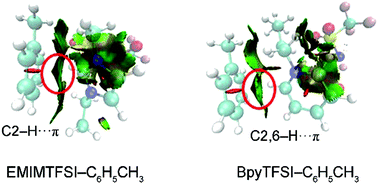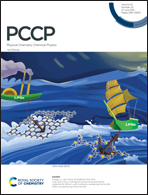The molecular behavior of pyridinium/imidazolium based ionic liquids and toluene binary systems†
Abstract
Imidazolium and pyridinium-based ionic liquids (ILs) have attracted increasing attention in the extraction of aromatic VOCs. However, fundamental studies on the mechanism of capturing aromatic VOCs have been less reported. In this work, the interactions between two ILs, 1-ethyl-3-methylimidazolium bis(trifluoromethylsulfonyl)imide (EMIMTFSI) and N-butylpyridinium bis(trifluoromethylsulfonyl)imide (BpyTFSI), and toluene (C6H5CH3), were investigated by using attenuated total reflection Fourier transform infrared spectroscopy (ATR-FTIR), excess infrared spectroscopy, hydrogen nuclear magnetic resonance (1H NMR) spectroscopy and quantum chemical calculations. Some conclusions were obtained as follows: (1) H atoms on EMIMTFSI/BpyTFSI were located above or below the benzene ring and were mainly formed as C2–H⋯π bonds and C2,6–H⋯π bonds with C6H5CH3, respectively. C–H⋯π bonds played a significant role in capturing aromatic compounds. (2) Upon adding C6H5CH3, the two IL-C6H5CH3 system's interaction strength was as follows: EMIMTFSI-C6H5CH3 > BpyTFSI-C6H5CH3. (3) Since C6H5CH3 was unable to disrupt the interactions between cations and anions of ion pairs in the two studied IL-C6H5CH3 systems, only ion cluster-C6H5CH3 and ion pair-C6H5CH3 complexes were observed. This work may provide theoretical insights into the separation mechanism for capturing VOCs.



 Please wait while we load your content...
Please wait while we load your content...